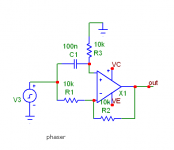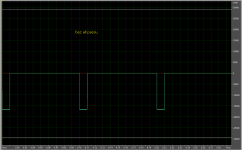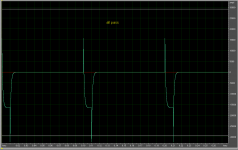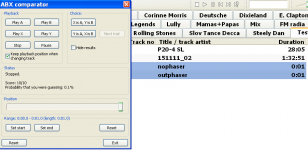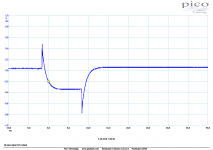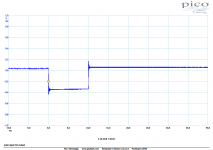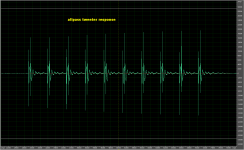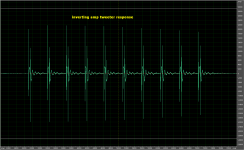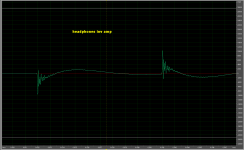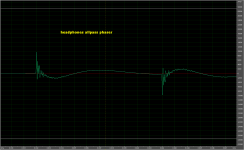Allpass circuits are the circuits with flat amplitude response but various phase response. They are usually used as phase shifters, crossover circuits etc. They modify time response though keeping flat amplitude frequency response. It is generally considered that in audio their effect is inaudible. One of many links supporting allpass inaudibility is Phase distortion written by a man who has done a great work in audio during his life.
IME under certain conditions, depending on time duration and signal shape, the allpass phase and time distortion may become audible. I have prepared an experiment to compare 2 files, generated in LTSpice. Input signal is a train of 10 rectangular impulses of 10ms width repeated every 100ms. The test signal duration is 1s. It passed through inverting opamp with gain 1 phaser circuit with opamp, three 10k resistors and 100nF capacitor
Test wav files from both circuits were prepared.
Attached one can see the test phaser circuit (simple inverting amp for the test built just by omitting the capacitor in the phaser), amplitude and phase plots of the phaser and inverting amp, time plot from the test wav files and finally the test files in the phaser1.zip file.
Please try the test files and tell me if you can hear the difference. Foobar ABX result or protocol would be appreciated, I am attaching my result with headphones.
A poll with 14 days duration is attached as well.
IME under certain conditions, depending on time duration and signal shape, the allpass phase and time distortion may become audible. I have prepared an experiment to compare 2 files, generated in LTSpice. Input signal is a train of 10 rectangular impulses of 10ms width repeated every 100ms. The test signal duration is 1s. It passed through inverting opamp with gain 1 phaser circuit with opamp, three 10k resistors and 100nF capacitor
Test wav files from both circuits were prepared.
Attached one can see the test phaser circuit (simple inverting amp for the test built just by omitting the capacitor in the phaser), amplitude and phase plots of the phaser and inverting amp, time plot from the test wav files and finally the test files in the phaser1.zip file.
Please try the test files and tell me if you can hear the difference. Foobar ABX result or protocol would be appreciated, I am attaching my result with headphones.
A poll with 14 days duration is attached as well.
Attachments
Last edited:
It is tested on XP as well. Works normally with Foobar, for example. Try the stereo version above, it might work for you. The issue might also be that the file is short (1s) and mediaplayer cannot play it.
Edit: just found that AIMP3 cannot play it. Regardless length and/or mono-stereo.
Edit: just found that AIMP3 cannot play it. Regardless length and/or mono-stereo.
Last edited:
You're generating an extreme case here. I can hear the difference, but it's slight.
Here's a quote from many years ago: (Maybe you'll recognize it.)
"It turns out that, within very generous tolerances, humans are insensitive to phase shifts. Under carefully contrived circumstances, special signals auditioned in anechoic conditions, or through headphones, people have heard slight differences. However, even these limited results have failed to provide clear evidence of a 'preference' for a lack of phase shift. When auditioned in real rooms, these differences disappear.."
Dave.
Here's a quote from many years ago: (Maybe you'll recognize it.)
"It turns out that, within very generous tolerances, humans are insensitive to phase shifts. Under carefully contrived circumstances, special signals auditioned in anechoic conditions, or through headphones, people have heard slight differences. However, even these limited results have failed to provide clear evidence of a 'preference' for a lack of phase shift. When auditioned in real rooms, these differences disappear.."
Dave.
Last edited:
I've tried this over and over using headphones and am unable to determine any difference using Foobar. Having said that I can swear I can hear a difference but have to put that down to some illusionary effect or perhaps just slight head movement altering the seal of the headphones and changing the subjective quality.
I got 6/10 over 5 runs and even got a 1 out of 10. That took some doing
I got 6/10 over 5 runs and even got a 1 out of 10. That took some doing
Well, I think that the test should be performed with a good soundcard and good headphones, first. Volume matters as well. I have tried it repeatedly and at right volume I get consistently positive result, like this:
I have also checked output of the DAC with a fast digi scope to verify that the output signal keeps correct shape. Measurements attached.
PC speakers would not work. We need a wideband response from low to high. Test pulses have wide spectrum from 10Hz to 20kHz. I will make a test with my regular speakers later, when it is more silent here. I will also try to prepare more files, more natural, if I find another audible ones.
Code:
foo_abx 2.0.2 report
foobar2000 v1.3.7
2018-10-07 09:19:28
File A: nophaser.wav
SHA1: ab2971518775e076a62721f96be61741f361cb94
File B: outphaser.wav
SHA1: 9d41fdd369cbd39150c239121c34f59a91b4fa58
Used DSPs:
Resampler (PPHS)
Output:
WASAPI (event) : Speaker (USB Sound Blaster HD), 24-bit
Crossfading: NO
09:19:28 : Test started.
09:20:26 : 01/01
09:20:32 : 02/02
09:20:39 : 02/03
09:21:01 : 03/04
09:21:08 : 04/05
09:21:33 : 05/06
09:21:45 : 06/07
09:21:53 : 07/08
09:21:58 : 08/09
09:22:13 : 09/10
09:22:13 : Test finished.
----------
Total: 9/10
Probability that you were guessing: 1.1%
-- signature --
ece9bc76246a2cd4a26bbd8c970e649f383664feI have also checked output of the DAC with a fast digi scope to verify that the output signal keeps correct shape. Measurements attached.
PC speakers would not work. We need a wideband response from low to high. Test pulses have wide spectrum from 10Hz to 20kHz. I will make a test with my regular speakers later, when it is more silent here. I will also try to prepare more files, more natural, if I find another audible ones.
Attachments
A more interesting test would be to measure the acoustic response of the headphones (via an appropriate test fixture) and see how recognizable those two test signals still are.
Dave.
I measured that with speakers. Farfield measurement is messed up with room response, so I made nearfield measurements at tweeter membrane. Attached.
Attachments
I have made a measurements of acoustic output of the headphones (Vivanco SR 750), we can see that the headphones transfer the initial phase of the test impulses properly. With inverting amp test signal, the pulse starts with negative edge, with the phaser it starts with positive edge.
Attachments
----------
Total: 10/16
Probability that you were guessing: 22.7%
-----------
First time I have done an ABX test in Foobar so the first part I was figuring out what I was supposed to be doing. Then the meat of the test was pretty much correct, then I was rushing toward the end through attention (caffeine) deficit.
If you took the middle 90% the result would be higher.
-----------------
As to the audibility of the phase change - I can hear a very slight change in the perceived pitch of the tone between one sample and the other. However it is so slight and requires so much concentration (as well as rapid cycling between samples), that I don't believe there would be any impact nor noticeability on music being played.
Total: 10/16
Probability that you were guessing: 22.7%
-----------
First time I have done an ABX test in Foobar so the first part I was figuring out what I was supposed to be doing. Then the meat of the test was pretty much correct, then I was rushing toward the end through attention (caffeine) deficit.
If you took the middle 90% the result would be higher.
-----------------
As to the audibility of the phase change - I can hear a very slight change in the perceived pitch of the tone between one sample and the other. However it is so slight and requires so much concentration (as well as rapid cycling between samples), that I don't believe there would be any impact nor noticeability on music being played.
I'm reading with interest. Related idle questions  :
:
How much phase distortion do typical electronics add? Isn't most of the phase distortion in the crossover filters? As with other types of distortion, isn't phase distortion in the electronics tiny as compared to the grotesque ones imposed by the transducer (speaker) and the listening room?
How much phase distortion do typical electronics add? Isn't most of the phase distortion in the crossover filters? As with other types of distortion, isn't phase distortion in the electronics tiny as compared to the grotesque ones imposed by the transducer (speaker) and the listening room?
...How much phase distortion do typical electronics add? Isn't most of the phase distortion in the crossover filters?...
If the electronics are "flat 20Hz-20KHz", the phase is about zero.
Each side of a crossover has phase shift. If both sides sum properly (not all do), the *combined* response should be little to no phase shift.
Loudspeakers (including headphones) can be quite wonky toward their limits.
- Status
- This old topic is closed. If you want to reopen this topic, contact a moderator using the "Report Post" button.
- Home
- General Interest
- Everything Else
- Audibility of allpass phase distortion (test)

